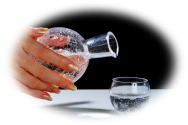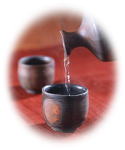| KIKIZAKESHI Masayuki Ohba Web site | |||
| KIKIZAKESHI Masayuki Ohba Web site | |||
| Data from research around the world indicates that a certain amount of
alcohol can help reduce the risk of heart disease, cancer, osteoporpsis,
amnesia, arterial sclerosis, heart attack, and liver cirrhosis. Since alcohol dilates blood vessels that have constricted due to stress, and stimulates blood capillaries, it stimulates the flow of blood, improving blood circulation. This helps to rejuvenate blood vessels, making them more resilient, and relax tightened muscles. It is also said that drinking alcohol has a soothing effects. |
| Known as sakamai ("sake rice"), the rice that is the primary
ingredient in sake is different from the rice eaten at table. Approximately
5% of the rice grown in Japan is sake rice. Of this, only rice that meets certain stipulations can be called premium sake rice. Only about 30% of the sake rice grown qualifies as premium sake rice. The quality of sake rice has a great effect on that of sake. |
| Waterconstitutes 80% of sake, making it just as vital an ingredient as
rice, and it plays a decisive role. But water cannot be transported, unlike rice that can be stored and carried, making it possible for any brewery to obtain quality rice. That is why all sake breweries throughout Japan are locates close to rivers or other water sources. If a brewery is luckly, its natural environment will provide delicious water for shikomi. High quality water equates to high quality sake. Hence the saying, "Where the water is good you'll find fine sake." |
|
|
 |
As the smallest variation in temperature can create complex and varied changes in sake's fragrance and flavor, sake can be drunk at wide variety of temperatures. Types of sake which have bright, fruity flavors such as ginjyo-shu and daiginjyo-shu, should be served chilled. However, this is just a general rule and any type of sake can be enjoyed according to the drinker's preference. As sake is chilled, the more its sweetness disappears, producing a clean, light flavor. Conversely, as sake is heated, the sweetness and umami swell to produce a taut dryness and depth; a complexity of flavor develops. The alcohol becomes more volatile, naking its flavor more noticeable. A sake that is llightly heated or just warm is the style most favored by sake drinkers, as it brings out the softness and umami of sake. |  |
| Yawaragi water is water drunk between one cup of sake and the next, offering a pause in proceedings. This is water refreshes the palate, and will help prevent sudden inebriation and excessive drinking. Yawaragi-water makes the drinker feel sake and food more delicious. |  |
| Copyright (C) 2010 Masayuki Ohba All Rights Reserved | ||